Ward Connerly Names His New Targets
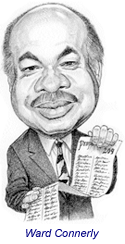 Fresh off his win banning affirmative action in university admissions in the state of Michigan, African-American businessman Ward Connerly has targeted nine other states where he may pursue similar ballot initiatives in 2008. Fresh off his win banning affirmative action in university admissions in the state of Michigan, African-American businessman Ward Connerly has targeted nine other states where he may pursue similar ballot initiatives in 2008.
The nine states are: Arizona, Colorado, Missouri, Nebraska, Nevada, Oregon, South Dakota, Utah, and Wyoming. But this project is largely show. Unlike Michigan and California where Connerly has achieved success before, there are very few college-bound blacks in most of these states. Also, the state universities in these nine states are not highly selective as is the case in Michigan and California. Therefore, a ban on race-sensitive admissions in these nine states will have little impact on black educational opportunities.
In the view of JBHE, Connerly is simply a self-serving mean man bent on advancing his ambitions on the backs of enough antiblack voters to harm his own people.
  |
“As a boy in Mississippi I grew up seeing people mistreated and abused and I’ve seen racial injustice all my life. Now as president of a Christian college, I’m in a position where I can do something about it.”
— Bill Crouch, president of predominantly white Georgetown College in Kentucky, announcing a new scholarship program for black students (Lexington Herald Leader, 12-6-06)
|
The Positive Trend in Black Student Graduation Rates at the Nation’s Highest-Ranked Universities
 Of the 27 high-ranked universities for which JBHE has long-term college completion data, the black graduation rate has improved at 24 institutions. Of the 27 high-ranked universities for which JBHE has long-term college completion data, the black graduation rate has improved at 24 institutions.
The greatest improvement in the black student college graduation rate has occurred at the California Institute of Technology. The black student graduation rate at CalTech has improved from 60 percent in 1998 to 83 percent in 2006. But there are so few black students at CalTech, usually one or two in each class, that the graduation rate figure can fluctuate to a large degree based on the performance of just one or two students.
Far more impressive is the 18 percentage point increase in the black student graduation rate at Carnegie Mellon University. There, the four year average black graduation rate rose from 47 percent in 1998 to 67 percent in 2006.
Similarly impressive gains in black student graduation rates have occurred at the University of Pennsylvania, Rice University, UCLA, and Columbia University. Each university has seen its black student graduation rate improve by at least 15 percentage points over the 1998 to 2006 period. Columbia University, which showed an 8 percentage point drop in black student graduation rates from 1993 to 1999, has rebounded over the past seven years. Since 1999 the black student graduation rate at Columbia rose from 72 percent to 87 percent.
The University of Virginia and Georgetown University have shown no improvement in their black student graduation rate over the period, but both schools maintain a very high success rate for graduating their black students.
The only decline in the black student graduation rates among the high-ranked universities in the past eight years was at Tufts University. There, the black graduation rate dropped from 82 percent in 1998 to 80 percent in 2006.
The Scientific Fields Where No African Americans Earned Ph.D. Awards in 2005
 A strong indicator of the fact that African Americans as a group continue to avoid most of the natural sciences appears in the statistics for Ph.D. awards in specific disciplines. In 2005, 2,275 doctorates were awarded by universities in the United States in the fields of geometry, computing theory and practice, astronomy, meteorology, theoretical chemistry, geochemistry, geophysics and seismology, paleontology, mineralogy and petrology, stratigraphy and sedimentation, geomorphology and glacial geology, acoustics, elementary particle physics, biophysics, nuclear physics, plasma/fusion physics, polymer physics, hydrology and water resources, oceanography, petroleum engineering, polymer and plastics engineering, communications engineering, engineering mechanics, ceramic science engineering, metallurgical engineering, agricultural engineering, engineering physics, mining and mineral engineering, ocean engineering, animal breeding, animal nutrition, agricultural plant breeding, plant pathology, horticultural science, fishing and fisheries science, forest science and biology, forest resources management, wildlife/range management, biotechnology, bacteriology, plant genetics, plant pathology biology, plant physiology, botany, anatomy, entomology, zoology, and veterinary medicine. A strong indicator of the fact that African Americans as a group continue to avoid most of the natural sciences appears in the statistics for Ph.D. awards in specific disciplines. In 2005, 2,275 doctorates were awarded by universities in the United States in the fields of geometry, computing theory and practice, astronomy, meteorology, theoretical chemistry, geochemistry, geophysics and seismology, paleontology, mineralogy and petrology, stratigraphy and sedimentation, geomorphology and glacial geology, acoustics, elementary particle physics, biophysics, nuclear physics, plasma/fusion physics, polymer physics, hydrology and water resources, oceanography, petroleum engineering, polymer and plastics engineering, communications engineering, engineering mechanics, ceramic science engineering, metallurgical engineering, agricultural engineering, engineering physics, mining and mineral engineering, ocean engineering, animal breeding, animal nutrition, agricultural plant breeding, plant pathology, horticultural science, fishing and fisheries science, forest science and biology, forest resources management, wildlife/range management, biotechnology, bacteriology, plant genetics, plant pathology biology, plant physiology, botany, anatomy, entomology, zoology, and veterinary medicine.
Not one of these 2,275 doctoral degrees went to an African American.
States That Are Most Successful in Delivering a College Education to Blacks
 Nationwide, U.S. Bureau of the Census data shows that nearly 4 million African Americans now hold a four-year college degree. In 2005, 17.6 percent of all African-American adults over the age of 25 held a four-year college degree. Since 1990 the percentage of African-American adults holding a bachelor’s degree has increased from 11.3 percent to 17.6 percent. This is remarkable progress in just a decade and a half. Nationwide, U.S. Bureau of the Census data shows that nearly 4 million African Americans now hold a four-year college degree. In 2005, 17.6 percent of all African-American adults over the age of 25 held a four-year college degree. Since 1990 the percentage of African-American adults holding a bachelor’s degree has increased from 11.3 percent to 17.6 percent. This is remarkable progress in just a decade and a half.
But the Census Bureau figures also show a wide discrepancy in college completions among African Americans in different states. The Census Bureau compiled data on the percentage of black adults with a bachelor’s degree in each of the nation’s 25 largest states in terms of population. These include most states with large black populations.
The statistics show that Maryland has the highest percentage of African Americans with a four-year college degree. Nearly 27 percent of all black adults in Maryland have at least a bachelor’s degree. It must be noted that large numbers of blacks in Maryland work for the federal government in and around Washington, D.C. Many of these African Americans have settled in Maryland but were not educated there.
More than 20 percent of all African-American adults in Minnesota, Washington State, California, and New Jersey hold a bachelor’s degree.
Only 9.2 percent of the black adults in Louisiana hold a four-year college degree, the lowest percentage among the largest states. But not all southern states fared poorly. The black percentage of the adult population with a college degree in Georgia, Texas, and Virginia was higher than the national average, which stands at 17.6 percent.

University of Wyoming
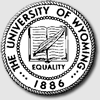
Elementary Humanities Education (Extended Term Academic Professional Lecturer)
Extended term, non-tenure track position. Qualifications: Earned graduate degree from a recognized program in teacher education with focus on social studies education; effective communication skills; experience working with pre-service teachers; 3 years of classroom teaching experience at prek-6 levels that includes social studies instruction. Preference for a doctorate in education with emphasis in social studies or elementary education, and experience teaching at the college level. Responsibilities: Active involvement as an interdisciplinary team member teaching general and content specific pedagogy in elementary humanities, and work in the public schools in collaboration with in-service and pre-service teachers. Included in this teaching responsibility is a willingness to travel to school sites within the state. Other responsibilities include advising and maintaining currency of knowledge through a program of professional development. Salary is competitive. Apply to Dr. Steven Locke (307) 766-6891 or slocke@uwyo.edu.
The University of Wyoming College of Education is strongly committed to attracting a diverse pool of faculty where cultural experiences and competencies are valued. More information is available at the College's website http://ed.uwyo.edu.
The University of Wyoming is an Affirmative Action, Equal Opportunity employer.

The Expanding Racial Scoring Gap on SAT II Subject Tests
Over the past several weeks, JBHE reported the large racial scoring gaps on SAT II subject tests. These tests are taken usually by only the cream of the crop of college-bound students, those applying to the nation’s highest-ranked colleges and universities.
Another important point to consider is whether the racial scoring gap on these tests is shrinking or expanding. Unfortunately, the news is not good. On the 12 most popular SAT II tests listed in the accompanying table, the racial scoring gap has increased on 10 of the 12 tests over the past seven years. On the physics test the racial scoring gap has remained the same over the past seven years. Blacks have made slight progress in lowering the racial scoring gap only on the world history examination.
The largest increase in the racial scoring gap has been on the Latin test. In 1999 the racial gap was only 15 points. It has now opened up to 45 points. The gaps have also opened significantly on the Spanish and French tests. Thus, while blacks generally do well on the foreign language tests compared to whites, the gap between the two groups is widening on these tests at a faster rate than in other subject areas.
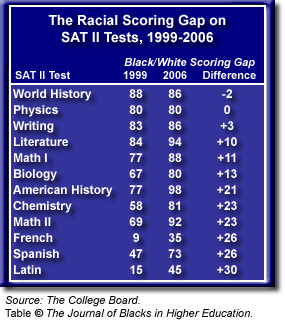
  |
56,520 State with the largest number of births to black mothers in 2005: Florida
62 State with the fewest number of births to black mothers in 2005: Montana
source: National Center for Health Statistics
|
Indiana University Boosts Financial Aid for Low-Income Students
 Indiana University, the state’s flagship university in Bloomington, will now pay the balance of all tuition and fees for low-income students from Indiana who qualify for federal Pell Grants. At the present time the maximum Pell Grant awards of $4,050 covers only about 60 percent of the cost of enrolling at Indiana University. The new awards do not include money for books or room and board. Indiana University, the state’s flagship university in Bloomington, will now pay the balance of all tuition and fees for low-income students from Indiana who qualify for federal Pell Grants. At the present time the maximum Pell Grant awards of $4,050 covers only about 60 percent of the cost of enrolling at Indiana University. The new awards do not include money for books or room and board.
It is expected that approximately 500 students will qualify for the new financial aid awards next fall. Low-income students will have to maintain a 3.0 grade point average while at Indiana University in order to maintain the financial aid.
 Three Finalists Named for Presidency of Florida A&M University Three Finalists Named for Presidency of Florida A&M University
This past weekend the Florida A&M University board of trustees interviewed six finalists for the position of president of the historically black university. The six candidates were narrowed down to three and the appointment of the new president is expected in March. The three finalists are:
- James H. Ammons, chancellor of North Carolina Central University in Durham, North Carolina
- Howard C. Johnson, provost and vice president for academic affairs at the University of North Texas in Denton
- Thelma B. Thompson, president of the University of Maryland Eastern Shore in Princess Anne, Maryland.
Of all these candidates it would appear that Dr. Ammons may be the favorite. He is a graduate of Florida A&M, has served on the faculty, and also was provost of the university before leaving to head North Carolina Central University.
Affirmative Action’s Last Gasps at the University of Michigan
 Last month, voters in Michigan approved Proposal 2 by a large margin. The referendum mandates that the University of Michigan and other state universities make their admissions decisions without regard to race. It was scheduled to go into effect this Saturday. But this week a federal court ruled that the state universities could continue to use race through the remainder of the current admissions cycle. Last month, voters in Michigan approved Proposal 2 by a large margin. The referendum mandates that the University of Michigan and other state universities make their admissions decisions without regard to race. It was scheduled to go into effect this Saturday. But this week a federal court ruled that the state universities could continue to use race through the remainder of the current admissions cycle.
The university reports that it experienced a surge in applications from underrepresented minorities since the November election. Applications from blacks, Hispanics, and American Indians are up 20 percent from the same date a year ago.
It appears that many blacks and other minorities filed their applications early in order that they be considered when their race or ethnicity could still be a positive factor in their admissions decision.
The University of Michigan reports that as of December 4, 73 percent of minority applicants were accepted for admission. About 59 percent of all white and Asian applicants were accepted.

University of Colorado at Boulder

Vice Chancellor for Research/Dean of the Graduate School
The University of Colorado at Boulder invites applications and nominations for the position of Vice Chancellor for Research/Dean of the Graduate School.
The Vice Chancellor for Research/Dean of the Graduate School, who reports to the Provost, serves as the chief research and graduate studies officer for the university. Responsibilities include recruiting and retaining outstanding faculty, researchers, students, and staff; facilitating interdisciplinary research collaborations; representing the Graduate School and research enterprise within the university community and with federal and state agencies; effectively managing the financial resources of the Graduate School; and engaging in successful fundraising activities. The anticipated starting date for the position is July 1, 2007.
For more information about the position and application process, please visit the link to Officer and Exempt Professional positions at http://www.colorado.edu/humres/jobs/.
The University of Colorado at Boulder is committed to diversity and equality in education and employment.

Awards
 • Boyce Courtney Williams, vice president for institutional relations at the National Council for Accreditation of Teacher Education, received the W.E.B. Du Bois Award from the National Alliance of Black School Educators. • Boyce Courtney Williams, vice president for institutional relations at the National Council for Accreditation of Teacher Education, received the W.E.B. Du Bois Award from the National Alliance of Black School Educators.
 • Olumuyiwa Ogunnika, a graduate student in electrical engineering and computer science at the Massachusetts Institute of Technology, received a $50,000 fellowship from the Center for Integration of Medicine and Innovative Technology. Ogunnika, a native of Brooklyn who was raised in Nigeria, is a graduate of City College of New York. He will use the fellowship to continue his study in research for a device to assess neuromuscular disease. • Olumuyiwa Ogunnika, a graduate student in electrical engineering and computer science at the Massachusetts Institute of Technology, received a $50,000 fellowship from the Center for Integration of Medicine and Innovative Technology. Ogunnika, a native of Brooklyn who was raised in Nigeria, is a graduate of City College of New York. He will use the fellowship to continue his study in research for a device to assess neuromuscular disease.
• Norman Francis, president of Xavier University, the historically black educational institution in New Orleans, was awarded the Presidential Medal of Freedom at a White House ceremony last week.
|

Maintaining Racial Diversity in the Face of an Affirmative Action Ban
 Blacks make up about 10 percent of the student body at the Wayne State University School of Law. But maintaining racial diversity on the Detroit campus was put in serious jeopardy when this November Michigan voters overwhelmingly passed Proposal 2, which bans the use of race in admissions decisions at state universities. Up to this point the law school has considered the race of black applicants as a positive factor in the admissions process. Blacks make up about 10 percent of the student body at the Wayne State University School of Law. But maintaining racial diversity on the Detroit campus was put in serious jeopardy when this November Michigan voters overwhelmingly passed Proposal 2, which bans the use of race in admissions decisions at state universities. Up to this point the law school has considered the race of black applicants as a positive factor in the admissions process.
In response to Proposal 2 the law school at Wayne State University has revised its admissions procedures with an eye toward maintaining racial diversity within the confines of the new law. Now admissions officers will give an advantage to applicants who come from a lower socioeconomic background, attended a low-achieving high school, were the first in their family to go to college, or to those students who have overcome discrimination or oppression. The new policy also will favorably view applicants from the city of Detroit where nearly 80 percent of the residents are black.
The initial proposal for changing the admissions policy included a provision giving preferences for American Indians. But fearing litigation for singling out a particular group, the policy was cleverly changed to give preference to people of any race who have had experience living on a reservation.
The Highest-Paid College Presidents Who Are African Americans
 A recent survey conducted by the Chronicle of Higher Education finds that compensation paid to college and university presidents has increased dramatically in recent years. The survey states that the median compensation for a president of public universities is nearly $375,000. A recent survey conducted by the Chronicle of Higher Education finds that compensation paid to college and university presidents has increased dramatically in recent years. The survey states that the median compensation for a president of public universities is nearly $375,000.
At private colleges and universities, many of which are quite small, the median compensation is under $300,000. But 10 percent of all private college and university presidents earn more than $500,000 a year.
Where do African-American college presidents stand? Shirley Ann Jackson, president of Rensselaer Polytechnic Institute, was ranked as the fourth highest paid president of a large research university. Her annual compensation, which is buffeted by membership on the board of directors of several large corporations, was close to $1 million.
Here we list the African-American college presidents included in the survey with the highest total compensation in 2005:
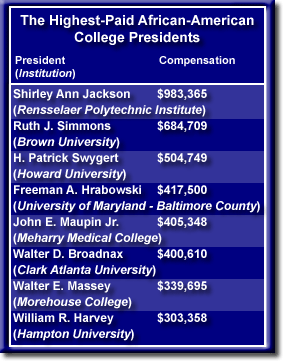

Eastern Washington University

College of Science, Health and Engineering
Department of Physical Therapy
The Department of Physical Therapy invites applications for a nine-month, full-time, tenure-track position beginning September, 2007. The position will be offered at the Assistant/Associate Professor level depending on qualifications. The Department of Physical Therapy offers the entry-level Doctor of Physical Therapy (DPT) and is located in a state-of-the-art Health Sciences Building located on the Spokane River in downtown Spokane. The city of Spokane, located in the Inland Northwest, has been rated 2nd in the nation for having the best summer weather. Recreational, social, and cultural opportunities are numerous.
Candidates must have a post professional doctoral degree (PhD or DSc), be eligible for licensure in the state of Washington, have a minimum of five years of clinical experience in Physical Therapy, teaching experience at the graduate level, and a high degree of interest in human and cultural diversity. Candidates will be expected to teach in their area of expertise, team teach in clinical research courses and contribute to other courses as needed. Research in the candidate’s area of interest and service to the department, university and profession are expected.
Candidates must submit a letter of application, current curriculum vitae, and names of three persons who can be contacted for references. Review of the candidates will begin immediately and will continue until the position is filled. The successful candidate will be required to pass a background check and show proof of eligibility to work in the US pursuant to US immigration laws.
Letter of application and curriculum vitas should be submitted to:
Byron Russell, PT, PhD
Chair, Department of Physical Therapy
Eastern Washington University
310 North Riverpoint Blvd, Box T
Spokane, WA 99202-0002
Tel: (509) 368-6608
E-mail: byron.russell@mail.ewu.edu
EWU is an Equal Opportunity/Affirmative Action Employer, and applications from members of historically underrepresented groups are especially encouraged.

School Choice Becoming Increasingly Popular With African-American Parents
 Black elected officials and the leaders of most black organizations are adamantly opposed to school choice initiatives. They believe that school choice programs will result in a brain drain of the best black students which will severely damage the schools in inner-city neighborhoods. Black elected officials and the leaders of most black organizations are adamantly opposed to school choice initiatives. They believe that school choice programs will result in a brain drain of the best black students which will severely damage the schools in inner-city neighborhoods.
Despite almost universal opposition among black leadership, black parents are increasingly taking advantage of school choice programs. New data from the Department of Education finds that in 2003, 24 percent of all black children in grades 1-12 in public schools now attend schools that they have chosen to attend. This is up from 19 percent in 1993. The percentage of all black students who attend schools to which they were assigned by the school district dropped from 77 percent in 1993 to 68 percent in 2003.
Blacks are also opting out of the public school system in other ways. From 1992 to 2003, the percentage of all black students enrolled in private schools doubled from 4 percent to 8 percent. The largest increase was for blacks enrolling in church-related private schools.
Blacks are also increasingly home-schooled. In 1999 blacks were 8 percent of all home-schooled students. Just four years later in 2003, blacks made up 10 percent of all home-schooled students.
Chicago Law Firm Helps Black Students Navigate and Succeed in the Law School Admission Process
 Sidley Austin LLP, a Chicago-based law firm, has established the Sidley Prelaw Scholars program in an effort to bring greater racial diversity to the legal profession. Under the program black and other minority students enrolled in a prelaw curriculum at colleges and universities throughout the United States are awarded up to $2,500 for a course to prepare them to take the Law School Admission Test, as well as registration fees for taking the LSAT, and application fees for up to seven law schools. In addition, each scholar receives a $2,500 scholarship for his or her senior year in college. Sidley Austin LLP, a Chicago-based law firm, has established the Sidley Prelaw Scholars program in an effort to bring greater racial diversity to the legal profession. Under the program black and other minority students enrolled in a prelaw curriculum at colleges and universities throughout the United States are awarded up to $2,500 for a course to prepare them to take the Law School Admission Test, as well as registration fees for taking the LSAT, and application fees for up to seven law schools. In addition, each scholar receives a $2,500 scholarship for his or her senior year in college.
The law firm recently announced its first group of 23 Sidley Prelaw Scholars. The awards will be made annually.
Who Gets the Most Financial Aid for College, Blacks or Whites?
In what will come as a surprise to many readers, the average amount of financial aid of all types received by white undergraduate college students is actually higher than the average amount of financial aid offered to African Americans. According to the U.S. Department of Education, in 2004 the average financial aid award to white undergraduates was $7,500. For blacks, the average aid award was $7,200.
On average, whites also received larger scholarship grant awards than blacks. In 2004 the average financial aid grant for whites was $4,000. For blacks, the mean grant award was $3,800.
One reason for this disparity is that a large percentage of African Americans are enrolled at historically black colleges and universities. Many of these schools have puny endowments and offer little in the way of financial aid. A large number of students at these schools are forced to rely on federal and state financial aid programs. In turn, many white students attend colleges and universities with large endowments that are able to supplement federal and state awards with generous financial aid packages of their own.
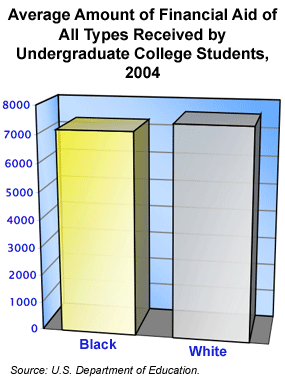
Slight Increase in Foreign Students From Africa at U.S. Colleges and Universities
From 1992 to 2001 there was a steady increase in the number of foreign students at U.S. colleges and universities. During this period the number of African students at U.S. colleges and universities doubled.
But after the September 11, 2001 terrorist attacks, it became more difficult to obtain a visa to study in the United States. In the 2002-03 academic year there were 40,193 students from Africa at American colleges and universities. Two years later, enrollments of students from Africa had dropped by more than 10 percent to 36,100.
Now it appears that the decline in students from Africa has abated. According to a new survey by the Institute of International Education, in the 2005-06 academic year there was a total of 36,308 students from African nations at U.S. colleges and universities. This was an increase of 208 students, or 0.5 percent, from the 2004-05 academic year.
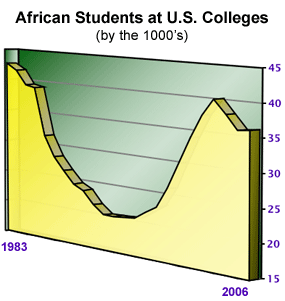

University of Missouri-St. Louis

Composition Specialists, Department of English
The University of Missouri-St. Louis seeks three Composition Specialists to join an established writing program as it moves into an exciting and well-supported new phase. Candidates interested in discipline-based communications, curriculum development, and teaching online and in technology-rich environments will find these opportunities particularly attractive. Successful candidates will demonstrate excellence in teaching college writing and expertise appropriate to developing and teaching upper division WAC/WID courses.
The positions are continuing, full time, non-tenure track Lectureships, offer the opportunity for promotion to Senior Lecturer, include full participation in departmental governance, competitive salary and privileges, full medical and retirement benefits, and University-supported professional development opportunities. Normal teaching load 4/4.
PhD preferred; other appropriate degrees considered. Start August 2007.
Please submit 1) a letter of application, 2) c.v., and 3) 1 page teaching philosophy to Dr. Suellynn Duffey, Chair, Lecturer Search Committee., English Department, 434 Lucas Hall, One University Blvd, St. Louis, MO 63121 by March 1, 2007.
The University of Missouri-St. Louis is an AA/EOE employer committed to excellence through diversity.

In Memoriam
Phyllis T. Garland (1935-2006)
 Phyllis T. Garland, a professor at the Graduate School of Journalism at Columbia University for over 30 years, succumbed to cancer last month. She was 71 years old. Phyllis T. Garland, a professor at the Graduate School of Journalism at Columbia University for over 30 years, succumbed to cancer last month. She was 71 years old.
A native of McKeesport, Pennsylvania, Garland was a graduate of the Medill School of Journalism at Northwestern University. She began her professional career as a reporter for the Pittsburgh Courier. In 1965 she joined the editorial staff of Ebony magazine where she worked for six years. In 1971, Garland left to take a faculty position at the State University of New York at New Paltz. While starting out in a new career in the academic world Garland remained a contributing editor at Ebony for nearly two decades. In 1973 she was appointed to the faculty at the Columbia School of Journalism. She was the first woman and the first African American to be awarded tenure at the school. Garland retired and received professor emerita status in May 2004.
Grants
• The nursing school at Fayetteville State University will participate in a $1.4 million grant from the U.S. Department of Health and Human Services for a program that will seek to increase the use of technology in nursing education. Joining historically black Fayetteville State University in the program will be the nursing schools at Duke University and Western Carolina University.
• Six historically black universities will participate in a $5.6 million grant program of the United States Department of Agriculture to assist the nation’s minority farmers. Under the program the black universities will offer educational training in farm management, financial management, and marketing to black and other minority farmers in communities near their campuses.
The black universities participating in the program are Florida A&M University, Prairie View A&M University, Tuskegee University, the University of Arkansas Pine Bluff, the University of Maryland Eastern Shore, and Virginia State University.
• City College of New York received a $10 million grant from the New York Life Insurance Co. for the establishment of the New York Life Endowment for Emerging African-American Issues at the college’s Colin Powell Center for Policy Studies. The fund will provide scholarships for 21 students each year and will also support eight paid summer internship positions.
|
 .
.